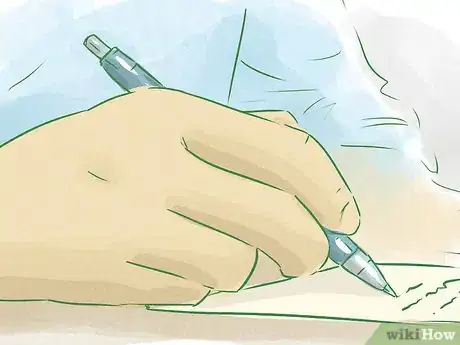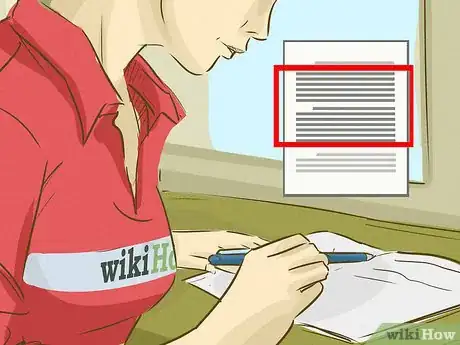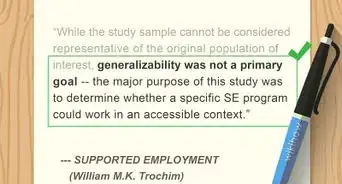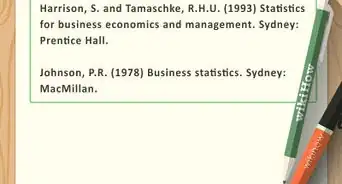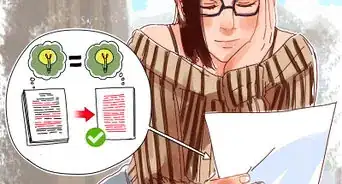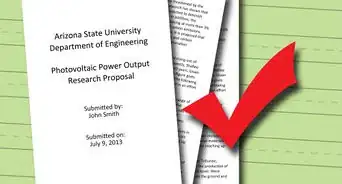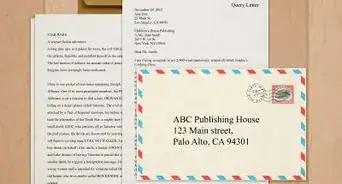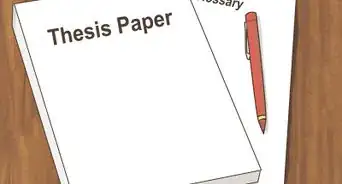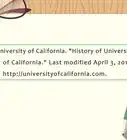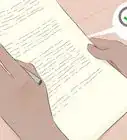X
This article was co-authored by Alexander Peterman, MA. Alexander Peterman is a Private Tutor in Florida. He received his MA in Education from the University of Florida in 2017.
This article has been viewed 26,636 times.
Rephrasing is a skill that comes in handy when writing a paper. When citing content, you need to be able to put information into your own words. To start, read the content carefully and rewrite it in your own voice. Then, review your work and tweak it as necessary to make sure you're being as clear as possible. Make sure the work is completely rewritten to avoid plagiarism.
Steps
Part 1
Part 1 of 3:
Putting Content in Your Own Words
-
1Read the content carefully. To ensure you rephrase content in your own words, careful reading is key. Read the content you're rephrasing over and over again until you feel you completely understand it.
- Take notes while reading the content. This way, you'll already be rephrasing it slightly.
- After reading each paragraph, pause and restate what was said. Imagine you're explaining the content to someone else.
-
2Do not use words from the original text. Unless you're quoting directly, make sure most of the original diction is cut from your writing. Some words may be unavoidable. For example, if you're talking about a particular science term, you'll have to use that word. For the most part, however, avoid the original words as much as you can.[1]
- For example, if you're writing about sex determination in chromosomes, you will have to use the term "chromosome."
- Some people think they can save time by simply replacing original words with synonyms. Not only is this likely to sound clunky, it can still be read as plagiarism if you don't change basic sentence structure.
Advertisement -
3Put the content in your own words. Imagine you were describing the information to someone unfamiliar with the topic to help you rephrase it. Describe the content to this imaginary person using your own original words.[2]
- For example, the original text says, "Out of the 46 chromosomes found in human DNA, sex is determined by the 'X' and 'Y' chromosome." How can you put this in your words? Try something like, "In humans, DNA is made up of 46 unique chromosomes. The determination of biological sex relies on the 'X' and 'Y' chromosomes."
-
4Build off the existing content. While you should rephrase the information to avoid plagiarism, the end goal is to use the information to support your own thesis or argument. Think of how the content relates to your particular paper or essay and build off the material you cite.
- For instance, if your paper is about determining gender during pregnancy, you might add, “Therefore, the best way to determine the gender of an unborn child is with a DNA test, not a sonogram.”
-
5Cite the source when you're done. Even if you've put the content into your own words, you need to source it. Follow the guidelines of the writing style you use (i.e., APA citation, MLA citation, etc.) and cite the source according to that style. Sources are sometimes cited in parentheses within the text or in footnotes/endnotes, as well as in a Works Cited page.[3]
Advertisement
Part 2
Part 2 of 3:
Rewriting for Clarity
-
1Figure out your main points. After paraphrasing a sentence or paragraph, read the original text. Try to restate the main point in one or two sentences. Then, reread your paraphrased words to make sure the original point is reflected there.[4]
- For example, suppose the original sentence reads, "In East of Eden, Steinbeck's characters are caught in a morally ambiguous divide between good and evil." The main point here is that characters in East of Eden live in a gray area.
- Reread your sentence. Suppose it says, "Steinbeck tries to illustrate how characters choose between good and evil." This sentence misses the point, as it glosses over the gray area.
- Tweak your sentence to reflect the main point. For example, "Steinbeck tries to illustrate how his characters exist between good and evil."
- For example, suppose the original sentence reads, "In East of Eden, Steinbeck's characters are caught in a morally ambiguous divide between good and evil." The main point here is that characters in East of Eden live in a gray area.
-
2Rephrase any confusing or incoherent sentences. Often, in an effort to paraphrase without plagiarizing, sentences often become poorly constructed and confusing. Read through your paraphrased words and watch out for sentences that are difficult to understand.[5]
- For example, say you wrote, "Characters in Mrs. Dalloway all suffer trauma due to World War I, which is illustrated through Clarissa being frightened by a car malfunctioning and more dramatically through the shellshocked Septimus Smith."
- This sentence is too long. It should be broken into smaller sentences. For example, "Characters in Mrs. Dalloway all suffer from trauma due to World War I. This is illustrated when Clarissa is frightened by a car malfunctioning. It is later shown more dramatically through the shellshocked Septimus Smith."
- For example, say you wrote, "Characters in Mrs. Dalloway all suffer trauma due to World War I, which is illustrated through Clarissa being frightened by a car malfunctioning and more dramatically through the shellshocked Septimus Smith."
-
3Provide all the necessary details. When striving to rewrite content, it can be easy to inadvertently leave out necessary details. Good paraphrasing should never be vague. Reread your words to make sure you conveyed all the necessary information.[6]
- For example, say a sentence says, "The murders occurred in 1991, in a small suburb just outside of Chicago at roughly nine o'clock in the morning." You wrote, "The family was killed near Chicago."
- Rewrite the above sentence to add the missing details. For example, "The family was killed in a suburb outside Chicago in 1991. The murders were estimated to have taken place around nine o'clock in the morning."
Advertisement
Part 3
Part 3 of 3:
Avoiding Plagiarism
-
1Change the structure in addition to the words. When you're rephrasing content in your own terms, sentence structure often changes naturally. However, if you find any of your sentences or paragraphs too closely mirror the original work, tweak the structure to avoid plagiarism.[7]
- Changing structure is a matter of starting with a different idea, fact, sentence, or passage.
- For example, say a paragraph of literary analysis began by overviewing character relationships before stating a theory on the work's theme. When paragraphing, state the theme first and then talk about character relationships.
-
2Add some of your own style. Think about your natural writing voice, tone, and style. Try to write content using your unique voice. This will help you naturally stray from the original content while providing a more engaging piece.[8]
- For example, take a paragraph that says, "Even after 40 years, the elephant remembered its training from when it was used in war."
- Be a little creative when paraphrasing. For example, "Proving the old adage about elephants never forgetting, the war elephant recalled its training from 40 years prior."
- For example, take a paragraph that says, "Even after 40 years, the elephant remembered its training from when it was used in war."
-
3Use quotes when necessary. Sometimes, it's okay to use the original source if your own words aren't enough to convey necessary information. If you decide to quote directly, use block quotes and quotation marks. Then, cite the source according to the guidelines you're using for your paper.[9]
- Make sure you don't quote too much, however. When writing, it's important to put some content in your own words rather than merely restating the work of other writers.
-
4Run your words through an online tool. There are many online tools that help you check for plagiarism. Just to be sure, copy and paste your words into an online tool like DupliChecker or Copyleaks. These tools will screen your words to make sure they do not too closely mimic existing content.[10]
- In addition, many teachers use online tools (such as Turnitin) to check their students’ work for plagiarism.
Advertisement
Community Q&A
-
QuestionHow do I paraphrase an article?
 Catherine TranCommunity AnswerFirst, pick out the main idea and important details that would help the support the main idea. Then, using those ideas and details, figure out a good pay of organizing the information. Lastly, using transitions to connect the ideas, put the details in your own words in an organized format.
Catherine TranCommunity AnswerFirst, pick out the main idea and important details that would help the support the main idea. Then, using those ideas and details, figure out a good pay of organizing the information. Lastly, using transitions to connect the ideas, put the details in your own words in an organized format.
Advertisement
References
- ↑ http://www.plagiarism.org/article/how-to-paraphrase
- ↑ http://www.plagiarism.org/article/how-to-paraphrase
- ↑ http://www.plagiarism.org/article/how-to-paraphrase
- ↑ http://examples.yourdictionary.com/examples-of-paraphrasing.html
- ↑ https://writing.wisc.edu/Handbook/QPA_paraphrase2.html
- ↑ https://www.kibin.com/essay-writing-blog/examples-of-paraphrasing/
- ↑ https://writing.wisc.edu/Handbook/QPA_paraphrase2.html
- ↑ https://www.kibin.com/essay-writing-blog/examples-of-paraphrasing/
- ↑ http://examples.yourdictionary.com/examples-of-paraphrasing.html
About This Article
Advertisement

